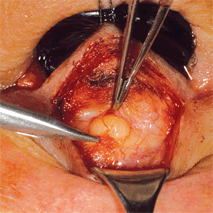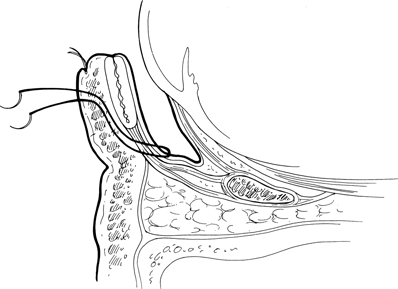6 Entropion

Entropion, an inward turning of the eyelid margin and appendages, remains one of the most common eyelid malpositions seen in clinical practice. The involutional variety is the most frequently encountered, whereas those cases of cicatricial etiologies are the most difficult to treat. The true spastic and congenital types are less commonly seen.
It is important to distinguish between entropion and eyelash misdirection or aberrant growth. Trichiasis is a misdirection of normal lashes, whereas distichiasis represents an abnormal growth of lashes from the multipotential tarsal meibomian glands. Normal lashes may be mechanically misdirected by exaggerated folds of skin. Epiblepharon, a redundant horizontal pretarsal skin fold, epicanthal fold, or dermatochalasis may push lashes toward the globe.
PREOPERATIVE EVALUATION
The constant rubbing of the eyelashes and eyelid skin against the ocular surface can result in abrasions of the cornea and conjunctiva. This often can progress to secondary stromal scarring, corneal thinning, and vascularization. Patients complain of a chronic foreign body sensation, redness, tearing, and discharge. Corneal ulceration and perforation may occur in extreme cases.
The approach to the evaluation and repair of entropion is intimately associated with knowledge of lower eyelid anatomy and function. The retractors of the lower eyelid are analogous to the levator aponeurosis and Müller’s muscle of the upper lid, and they greatly contribute to lower eyelid function and stability. An extension of the inferior rectus muscle, the capsulopalpebral head, travels forward in the inferior orbit, surrounds the inferior oblique muscle, and contributes to the formation of Lockwood’s ligament. It then continues forward and superiorly, fuses with the orbital septum, and has multiple insertions, the strongest being to the inferior border of the tarsus (see Chapter 1). Attenuation or disinsertion of these attachments of the lower eyelid retractors renders instability of the tarsus and subsequent inward rotation of the lid margin. This is probably the most frequently encountered anatomic defect found in involutional entropion.
The lower eyelid retractors have fine extensions to the orbicularis and eyelid skin. A weakening of the extensions, along with loss of the attachments between the preseptal orbicularis muscle and the orbital septum, allows the preseptal orbicularis to override the pretarsal orbicularis. Spasms of the orbicularis may occur because of an acute inflammatory episode and result in a temporary entropion. However, almost all cases that were once termed spastic are now known to represent involutional entropion, with the associated lower eyelid anatomic pathology.
The lateral and medial canthal tendons rigidly anchor the lids to the orbital bony periosteum. Horizontal laxity of the lids results when stretching of these tendons, especially the lateral canthal tendon, allows displacement and loss of elasticity of the lower eyelid. These changes can be a factor in the functional abnormalities of both entropion and ectropion of the lower eyelid.
Eyelid Evaluation
The etiology of entropion may include multiple factors, including loss of the integrity of the lower eyelid retractors and the canthal tendons, secondary overriding of the preseptal orbicularis oculi muscle, and a decrease in orbital volume caused by trauma or relative enophthalmos secondary to aging changes. Cicatricial processes secondary to ocular or systemic disorders or trauma may produce shrinkage of the conjunctival fornices, symblepharon formation, and distortion and metaplasia of the lid margin and meibomian glands.
The lower eyelid retractors contribute to a 3- to 4-mm downward excursion of the lower eyelid on down gaze. Loss of this movement may indicate weakening or disinsertion of the lower eyelid retractors. Horizontal eyelid laxity, caused by canthal tendon laxity, can be quantitatively evaluated by noting the relative elasticity of the eyelid by pulling the lid downward and observing the movement of snapping back to its original position without allowing blinking. Another method of evaluation involves pulling the lid forward and noting the relative amount of dislocation away from the globe that is produced. Forceful squeezing of the eyelids by the patient may reproduce an intermittent entropion and permits observance of the overriding of the preseptal orbicularis on the tarsal eyelid.
Cicatricial components should be suspected if resistance to downward traction is encountered and if horizontal traction on the lid does not temporarily improve the entropion. Difficulty of lid eversion also may be present in these cases. The conjunctival fornices should be inspected for symblepharon and shallowing of the entire fornix, as well as conjunctival, lid margin, and meibomian gland abnormalities.
Procedural Choices
The techniques that have withstood the test of time have addressed the lower eyelid retractors as essential in the functional abnormality of entropion.
Full-thickness eyelid sutures remain a popular office or bedside procedure for involutional and spastic entropion. They indirectly tighten the lower eyelid retractors and transfer the eversion force to the anterior lamella (orbicularis and skin). This is accomplished by promoting an inflammatory cicatrix between the retractors and the orbicularis muscle and by anchoring the skin and orbicularis, preventing overriding of the preseptal orbicularis muscle. The use of full-thickness sutures is quick, easily performed, and gives immediate relief. However, its relatively high recurrence rate limits its usefulness for a definitive long-term correction. Horizontal laxity is often present, and increased long-term success can be achieved by combining full-thickness sutures with a lateral tarsal strip procedure (Chapter 7).
Direct repair, including advancement and tightening of the lower eyelid retractors, allows an anatomic correction of the defect in most patients. This repair is analogous to the aponeurotic repair of ptosis of the upper eyelid. Intraoperative adjustment and evaluation of lid contour and function yield more predictable results. A lid-tightening procedure is often indicated as an adjunct to eyelid retractors repair. For horizontal eyelid tightening, the lateral tarsal strip procedure is preferred. Medial canthal tightening, and excision of excess skin and orbicularis muscle, can also be utilized in selected cases.
Rotation of the eyelid margin can also be employed for involutional and mild to moderate cases of cicatricial entropion. A full-thickness horizontal incision disinserts all attachments of the lower eyelid at the level of the inferior border of the tarsus. This full-thickness defect is then repaired to transfer the eversion effect of the lower eyelid retractors to the anterior lamella of the remaining lid margin bridge flap. This is similar in concept to the full-thickness suture technique but is done under direct visualization, and it promotes a much better-defined scar tissue barrier to shorten the retractors, evert the tarsal plate, and inhibit upward overriding of the preseptal orbicularis muscle.
A modification of this procedure is used in the upper lid for mild to moderate cicatricial entropion. In these cases, the upper eyelid tarsus is incised horizontally 4 to 5 mm above the lid margin. The posterior lamella is similarly sutured to the anterior lamella of the bridge flap to accomplish rotation of the upper eyelid margin.
SURGICAL TECHNIQUES
Full-Thickness Sutures
Topical tetracaine is applied and 2% lidocaine with 1:100,000 epinephrine is injected subcutaneously and subconjunctivally. The lower eyelid is pulled away from the globe with forceps. One arm of a double-armed 4–0 chromic suture is passed in a perpendicular fashion through the eyelid, starting deep within the inferior fornix. The conjunctiva is entered well below the inferior border of the tarsus, and the retractors are engaged with the needle tip.

Figure 6-1. A sagittal view of suture passage through the lower eyelid. The skin and the preseptal orbicularis muscle are retracted downward with forceps, and the needle is then passed through the orbicularis and skin to exit about 2 to 3 mm below the lash line. The needle exit point can be placed higher or lower, depending on the amount of eversion effect desired.
The other arm of the suture is passed 3 mm from and parallel to the first arm. It is brought through all the layers of the lid in an identical fashion. The arms of the suture are tied to each other tightly to evert the eyelid.
Stay updated, free articles. Join our Telegram channel

Full access? Get Clinical Tree


